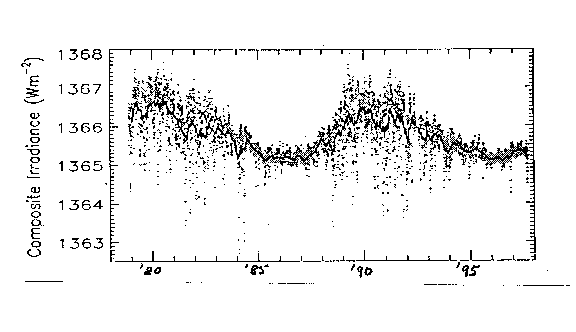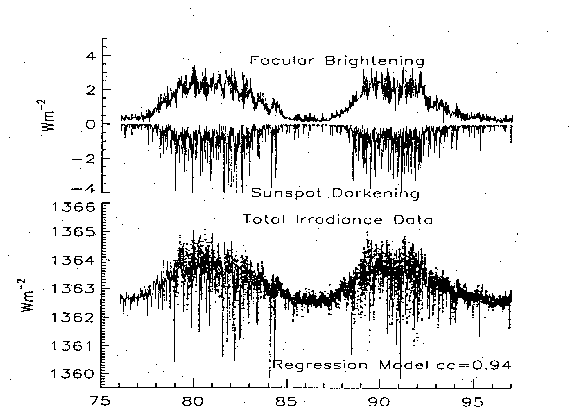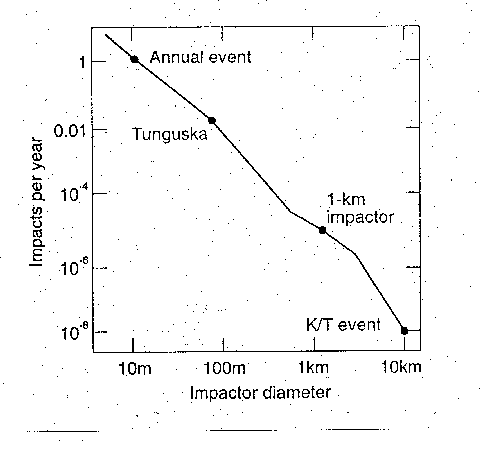Climate Change and Space Weather
Overview
Space weather refers to changes in the space environment and the effects that those changes have on mankind's activities. The primary source of space weather is the Sun. Variation in the electromagnetic and particulate output of the Sun is the main cause of changes in the Earth's upper atmosphere and surrounding regions such as the magnetosphere. These affect communications, navigation and many other space and ground based systems.
Under normal conditions it is the general belief that space weather does not couple significantly to tropospheric weather. Despite many thousands of papers that have been written on the subject (5,6), there is very little evidence of any consistent tropospheric phenomenon that can be tied to observed solar variations.
One of the main reasons for this is that the bulk of the solar radiation, which lies mainly in the visible and near infrared parts of the EM spectrum, shows very little change over historical time scales. Most of the variation occurs in the lower and upper parts of the solar spectrum; the radio and X-ray bands. At these wavelengths, the solar radiation can vary by many orders of magnitude. These variations are very noticeable in the ionosphere, but since none of the X-ray radiation in particular, penetrates below about 60 km there is no reason to believe any changes would be noticed in the mesosphere where "climate" takes place.
Particulate radiation from the Sun is also subject to extremely wide fluctuations. However, most of the particles have energies below (and usually well below) 100 MeV. The Earth's magnetic field is very effective in deflecting and/or trapping this radiation with most particles not reaching altitudes below about 50 km. The exception to this may be in the polar regions, although even particles travelling downward along the near-vertical polar magnetic field lines will generally be stopped by the dense layers of atmosphere. Occasionally very high energy particles (some with relativistic energies) do make it to ground level. This occurs just a dozen or so times per solar cycle and is referred to as a Ground Level Event (GLE).
Galactic cosmic rays have much higher energies than do solar cosmic rays (protons), and these make it through several atmospheric interactions all the way to the ground, mostly in the form of mu-mesons. This galactic cosmic ray flux is subject to solar influence in the form of heliospheric magnetic fields that can deflect and thus decrease the intensity of the flux. It has been speculated that this variation could cause precipitation variations with cosmic ray interactions providing condensation nuclei ("seeds" for initiating precipitation) in the upper troposphere. Again the evidence is not strong.
Some work has revealed the existence of two areas in which space weather might influence global climate change. The first, of solar origin, relates the small variations in total solar radiation (1), now well documented by satellite cavity radiometers over many years, to long term climatic effects. The second, entirely unrelated to solar flux variations, has been the investigation of impacts by kilometre size bodies (asteroids and comets) on the Earth's surface (2).
SOLAR ENERGY VARIATIONS AND CLIMATIC CHANGE
Solar Irradiance Measurements
Full spectrum cavity radiometers on board 7 spacecraft have now monitored the total electromagnetic radiation output from the Sun, called the solar constant, over about 20 years (1,4). The average value of the solar constant at the mean distance of the Earth from the Sun (referred to as the Astronomical Unit and equal to 1.496x1011 m) is about 1370 watt/square metre. This has shown an intrinsic solar variation over the course of solar cycles of just under 0.1% (figure 1). [There is also a variation due to the Earth's elliptical orbit, but the measurements in question are standardised to a distance of 1 Astronomical Unit (AU)] It is uncertain how indicative this solar variation is, measured over just 20 years, of variation in solar radiation.
There has been some work that has attempted to identify the source of these changes (4). It is now believed that most solar irradiance variations originate in solar surface magnetic activity. Approximately 80% of the measured variation can be accounted for by the two main visible features on the solar disc; sunspots and faculae. Sunspots are small dark areas on the solar disc whereas faculae are bright areas which form complex networks. Both of these phenomena occur around "active regions" where the magnetic field strengths are particularly high. Around sunspots the magnetic field strength can rise to thousands of gauss, whereas the average field is on the order of 1 gauss. The presence of faculae is highly correlated with the presence of sunspots, and hence with Sunspot Number (SSN). Over long time scales of months or greater it appears that increased irradiance due to the bright faculae exceeds the deficit due to the darker and cooler sunspots (Figure 2).
There has been a claim that solar irradiance from one minimum to another (8) [an 11 year period], when no spots or faculae are visible, does show a small change, but the general consensus is that any such non-magnetic variation, if it exists, is within the noise level (maybe 0.02%).
It is thus thought that sunspot number is a good proxy for solar irradiance changes, and historical variations in this number have led to a belief that the total variation of solar irradiance over time scales of thousands of years is unlikely to exceed 1%. This assumes that no non-magnetic related effects are likely to show up in the longer time scales.
The other way to approach the problem is to examine a sample of Sun-like stars for irradiance fluctuations. When this is done, the Sun does appear to be abnormally quiet. There is a report that suggests the average G type (Sun-like) star shows a 4% irradiance variation over a timescale of decades (9). Further, this variation may well be due to non-magnetically related activity, and is thus a phenomenon that we do not see at present in our Sun.

Figure 1
Solar irradiance variations as recorded by a composite of satellite
sensors for the latter part of the 20th Century.
The continuous line is an 81 day running average. (from reference 4)

Figure 2
Solar satellite irradiance data showing
modelled contributions due to sunspots and
faculae separately. (from reference 4)
Solar Driven Global Climatic Change
Whilst a 0.1% variation is unlikely to produce measurable climatic change (particularly with a period of just a decade), a 4% variation would certainly be noticeable. Alternatively, a variation with a much longer period and amplitude under 1% could well influence global climate. John Eddy and others (3,22) have claimed such climatic changes have occurred in the past, one particular association being a colder epoch in Europe during an apparently complete absence of sunspots over a 70 year period in the 17th century. Such claims have generated interest particularly amongst those who challenge the majority belief of enhanced greenhouse warming caused by anthropological activities over the past two centuries (23).
Terrestrial hypervelocity impacts and climate change
Definition and Description
A hypervelocity impact is one where the kinetic energy of the impactor, an asteroid or comet, exceeds the energy that the object would possess if all its mass were conventional explosive. By virtue of the Earth's gravitational potential energy, all bodies on a collision course with the Earth have a velocity in excess of 11 km/s (and usually less than the solar system escape velocity at Earth's orbit, which is 72 km/s). Any impact at these speeds is a hypervelocity impact. However, the Earth's atmosphere acts as a good shield against common impactors. Most potential impacts are from very small bodies. Their interactions produce the meteors that we see in the night sky. Small meteoroids are usually turned to dust, while their very high cosmic velocity is reduced to a very low terminal velocity in the atmosphere. The resultant dust particles drift down to the surface over several months or years. Each year our planet accumulates approximately 40,000 tonnes of extraterrestrial matter from these interactions.
A meteoroid needs to be several metres or even tens of metres in diameter to have a chance of making it to the Earth's surface with its space velocity unchanged. If is does so, the energy of impact causes near total vaporisation of the object, as well as excavating an impact crater much larger than the original diameter of the impactor.
If the diameter of the impactor is about one kilometre, the amount of material vaporised and thrown into the atmosphere is sufficient to cause global changes (2). There are two cases to consider, an impact on land and an impact on water. Water is more common because of the greater area of the world's oceans (70%) compared to land.
Terrestrial Hypervelocity Impacts
Much study has been conducted into the consequences of hypervelocity impacts on land (12,14). Detailed computer simulations have been performed to study the entry through the atmosphere, impact, the trajectories of fragments and various consequences (20). The most significant effect in terms of global climate change comes from the "nuclear winter" resulting from the massive amounts of dust ejected into the stratosphere. This dust would circulate the globe for many months, blocking sunlight essential to plant photosynthesis, causing knock-on effects right up the food chain. It is thought that after a few years, the dust would precipitate out, but not before severe mass extinctions had occurred (15). Such a scenario has been much discussed in connection with the Cretaceous/Tertiary ("K/T") boundary of around 65 million years ago.
Oceanic Hypervelocity Impacts
Hypervelocity impacts into the ocean are only just beginning to receive detailed study. The major effects here relate to the injection of massive quantities of water vapour into the stratosphere and higher atmospheric layers. Water vapour is a greenhouse gas, and the overall effect appears to be a substantial increase in the global temperature, just the opposite of what is expected for a continental impact. A more immediate and perhaps more frightening result of an ocean impact would be the production of massive tsunamis (13).
Geological Evidence
There are currently around 150 impact craters that have been positively identified on the Earth (10). Over 25 such craters have so far been found in Australia (21). Seven submarine impact structures are also known (18). Following the 1980 paper by Alvarez et al (17), there now appears to be a majority opinion that impact cratering has played a significant role in Earth's recent geological history.
A tentative identification of the impact crater that caused the K/T boundary event has been claimed for a large structure off the northern coast of the Yucatan peninsula (16). Increased values of osmium and iridium, elements associated with extraterrestrial meteorites, have been found in geological strata corresponding to the K/T time period. Ripple-like deposits in Texas and South Dakota have also been association with this event (11) as evidence of the tsunamis resulting from the impact. These claims imply that the tsunami travelled more than 1500 kilometres inland.
Future Probabilities
The population of Near Earth Objects (NEOs) over a range of sizes has been estimated by extrapolation from small bodies (whose frequency is well known), and from the rate of return of larger (kilometre size) objects (2). Figure 3 gives the current estimates for impact rates as a function of impactor size (7).
It is thought that the population of NEOs larger than a kilometre is around 2000 with upper and lower estimates of 4000 and 1000. A kilometre in size is significant because it is believed to be the approximate size of impactor for which major global effects will occur. From Figure 3 we see that the estimated frequency for impacts from kilometre sized bodies is about one every 100,000 years.

Figure 3
Estimated impact frequencies as a function of impactor diameter (7).
Summary
In the current epoch, the Sun is the source of most variations in our near space environment. These variations are called "space weather" and affect a variety of technological systems both ground and space based. Space weather does not appear to cause immediate and direct effects in the troposphere or biosphere of the planet. However, we have reason to expect that space weather might be more significant for the biosphere in the longer term.
Small variations in total solar irradiance have been detected from satellite based radiometers over the last 20 years. These variations appear too small in amplitude and have too short a period to be a factor in recent climate changes. Studies of other Sun-type stars indicate that larger variations in irradiance, of the order required to affect climate on Earth, do occur on Sun-like stars. Some claims of historical climatic effects, resulting from solar irradiance variations, have been made from statistical correlations with various solar indices.
Impacts from space debris which travels in Earth-crossing orbits can be expected to cause global disturbances to the Earth's climate at intervals of the order of 100,000 years. Much larger disturbances, probably leading to massive biosphere extinctions, appear to have occurred at intervals of the order of 100 million years.
Other space weather phenomena from outside the solar system which have the potential to cause global climate changes include galactic cosmic rays, nearby supernovae, interstellar dust clouds, binary star de-orbits, gamma ray bursters (19) and X-ray stars.
References
- K S Balasubramaniam, J W Harvey & D M Rabin (editors), Synoptic Solar Physics, Astronomical Society of the Pacific (1998)
- Tom Gehrels (editor), Hazards Due to Comets and Asteroids, University of Arizona Press (1994)
- J A Eddy, The New Solar Physics, American Association for the Advancement of Science (1978)
- J Lean & C Frohlich, Solar Total Irradiance Variations, in (1) pp281-292
- J R Herman & R A Goldberg, Sun, Weather and Climate, NASA SP-426 (1978)
- Geophysics Study Committee, Solar Variability, Weather & Climate, National Academy Press, Washington DC (1982)
- Duncan Steel, Rogue Asteroids & Doomsday Comets, Wiley (1995)
- R C Willson, Science, v277, p1963- (1997)
- G Lockwood, Luminosity & Chromospheric Variations of Solar Analog Stars, in (1) pp261-269
- R A F Grieve & E M Shoemaker, The Record of Past Impacts on Earth, in (2) pp417-462
- Investigations by P Stoffer USGS (to be published)
- V V Adushkin & I V Nemchinov, Consequences of Impacts of Cosmic Bodies on the Surface of the Earth, in (2) pp721-778
- J G Hills, I V Nemchinov, S P Popov & A V Teterev, Tsunami Generated by Small Asteroid Impacts, in (2) pp779-789
- O B Toon, K Zahnle, R P Turco & C Covey, Environmental Perturbations Caused by Asteroid Impacts, in (2) pp791-826
- M R Rampino & B M Haggerty, Extraterrestrial Impacts and Mass Extinctions of Life, in (2) pp827-857
- J Smit, Extinctions at the Cretaceous-Tertiary Boundary: The Link to the Chicxulub Impact, in (2) pp859-878
- L W Alvarez, W Alvarez, F Asaro & H V Michel, Extraterrestrial Cause for the Cretaceous-Tertiary Extinction, Science, v208, pp1095-1108, 1980
- H Dypvik & M Attrep, Geochemical Signals of the Late Jurassic, Marine Mjolnir Impact, Meteoritics & Planetary Science, v34(#3) pp393-406, 1999
- Peter T J Leonard & Jerry T Bonnell, Gamma-Ray Bursts of Doom, Sky & Telescope, pp28-34, February 1998.
- H J Melosh, Impact Cratering, Oxford University Press (1989)
- A Y Glikson, A Compendium of Australian Impact Structures, AGSO Journal of Geology & Geophysics, v16(#4), pp371-372 (1996). Note: Thematic issue on Australian Impact Structures.
- J Lean & D Rind, Evaluating Sun-Climate Relationships since the Little Ice Age, J Atmos & Solar-Terrestrial Physics, v61, pp25-36 (1999)
- S F Singer, Human Contribution to Climate Change Remains Questionable, EOS, April 20 pp183-187, (1999)
Material prepared by John Kennewell and Andrew McDonald





